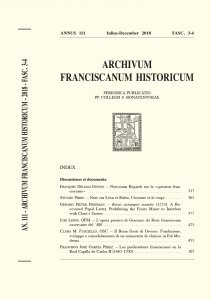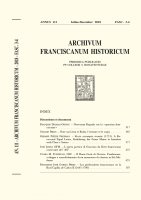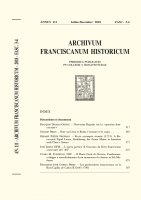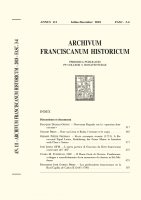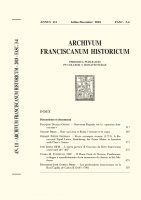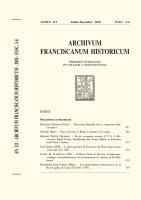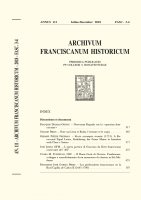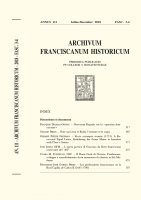SUMMARIA AFH 3-4 2018
François Delmas-Goyon. – Nouveaux Regards sur la « question franciscaine » (317-364)
Otto anni dopo la pubblicazione di François d’Assise. Écrits, Vies, témoignages, una gran parte dei progressi fatti da Jacques Dalarun, Sylvain Piron e l’autore riguardo l’identificazione dei documenti inviati dai tre compagni l’11 agosto 1246, la struttura della Compilazione di Assisi e gli sviluppi dei ricordi annotati da fra Leone, rimangono ancora sconosciuti nella comunità scientifica. Questo articolo espone questi progressi e risponde alle critiche che sono state avanzate alla nuova edizione francese delle Fonti Francescane. Evidenzia inoltre le notevoli conseguenze derivanti dal ricorso ad un «setaccio extrafino» nell’analisi letteraria della Compilazione di Assisi, che consente di proporre un’interpretazione innovativa della natura e del significato delle narrazioni che comprendono l’espressione: nos qui cum eo fuimus.
Sylvain Piron. – Note sur Léon et Rufin, l’écriture et le corps (365-375)
Questa breve nota amplia la riflessione proposta nel precedente articolo di F. Delmas-Goyon (cf. AFH 111 [2018] 317-364) sul rapporto tra i tre firmatari della Lettera di Greccio, un testo collettivo che enuncia un’azione e una volontà comune e che avrà un unico redattore, fra Leone. Questa lettera era accompagnata da un dossier di documenti contenenti i «fiori più belli», ovvero i ricordi dei primi compagni, annotati da fra Leone su fogli di pergamena cuciti successivamente insieme, e la Leggenda dei tre compagni, trasmessa da fra Rufino. Nell’ultima parte del testo, l’A. mostra che Leone e Rufino contribuirono, ciascuno per la sua parte e con metodi diversi, allo stesso progetto, che doveva ricordare quale fosse stata la presenza fisica di Francesco, in vista dell’«edificazione di coloro che vogliono imitare il suo esempio».
Gerard Pieter Freeman. – Recto assumpto tramite: A Recovered Papal Letter, Prohibiting the Friars Minor to Interfere with Clare’s Sister (377-423)
Recto assumpto tramite (RectoAT) è una lettera papale ‘misteriosa’ del 1253 di cui non esiste nessuna copia. L’unica nostra conoscenza dei suoi contenuti risale ad un riassunto contenuto nei Firmamenta trium ordinum (1512) che però propone delle affermazioni storicamente insostenibili. Lo storico L. Oliver aveva dichiarato nel 1912 che la RectoAT doveva essere un falso. Nessuno ha mai contraddetto lo storico francescano fino ad oggi, quando una clarissa irlandese ha recentemente segnalato l’esistenza di una traduzione inglese della RectoAT, presente in due piccole collezioni di scritti normativi del 1658 e 1665 e destinate alle clarisse di Gravelines. L’articolo esamina il testo, concludendo che si tratta probabilmente di un’accurata traduzione di una autentica lettera papale. Abbozza poi i diversi ruoli che questo documento ‘misterioso’ ha svolto dal 1512 fino ai nostri giorni.
Juri Leoni, OFM. – L’opera poetica di Giacomo da Rieti francescano osservante del ‘400 (425-453)
With this contribution, the author offers the edition of four unpublished poems by Giacomo of Rieti, a Franciscan Observant of the 15th century: the Versus de Cruce, the Epistola in hexameter to Pope Pius II, an Epitaphium in honor of St. Bernardine of Siena and the Versiculi in honor of St. Nicholas of Myra. The reconstruction of the poet’s personality, despite fairly good documentation attesting to his activity in the Roman Province and contact with Bernardine of Siena and John of Capistrano, is still problematic and not without obscurities. In an appendix, the transcription of an unpublished letter by Giacomo of Rieti to John of Capistrano is offered.
Clara M. Fusciello, OSC. – Il Buon Gesù di Orvieto. Fondazione, sviluppo e consolidamento di un monastero di clarisse in Età Moderna (455-505)
The “Buon Gesù” in Orvieto, founded in 1559, is an example of a Poor Clare monastery of the Modern Age, in a town belonging to the Papal States. The monastery was born out of an initiative of the municipal administration for poor young girls; it experienced a long period of growth and prosperity thanks to an endowment by Muzio Cappelletti. His bequest was meant to provide dowries for young girls taking the veil without financial means, yet these dowries were actually given to Orvieto’s eminent families. The article highlights, by means of archival sources, the close ties between Orvieto’s leading classes and the monastery, which had become an alternative solution within the strategies of marital alliances. Yet, these same links exposed the “Buon Gesù” to the dialectic of the political and economic interests of the local power. These dynamics have been sufficiently studied. It then gives an outline of the internal life from an economic and liturgical point of view, highlighting practices which differed from the ecclesiastical norm.
Francisco José García Pérez. – Los predicadores franciscanos en la Real Capilla de Carlos II (1655-1700) (507-543)
This article aims to study the presence of the Franciscan Order in the Royal Chapel of Charles II, and more specifically among the royal preachers. Along these lines it analyses the general characteristics of the friars who obtained the title of royal preacher, their links with the elite and their participation in the political evolution of the Catholic Monarchy. Finally, special attention is given to the sermons they preached from the pulpit of the Royal Chapel and the main churches of Madrid. Two appendices provide a list of 61 Franciscan royal preachers (with a special focus on the Friars Minor) between 1666 and 1699, and some extracts of the files of their nomination
Concetto Del Popolo. – Ancora per la «Preghiera davanti al Crocifisso» (545-549)
MS. Ross. 729 of the Vatican Apostolic Library, is a late 15th-century miscellany of Veronese origin, containing excerpta and works of illustrious as well as anonymous authors. It also includes the Oratio devotissima quam venerabillis pater noster Francischus devote dicebat ad Crucifixum. Although the historical context of the San Damiano account is not given, the prayer as contained in MS. Ross. 729 corresponds to the “substance” of this text, as Carlo Paolazzi calls it in his critical edition. Despite one lectio singularis, the witness enriches the recensio and offers ideas for further critical reflection.
Giulia Spoltore. – Una lettera di Luke Wadding ad Ilarione Rancati sull’Immacolata Concezione (551-556)
The article presents and transcribes an unpublished letter addressed by friar Luke Wadding to the Cistercian abbot Ilarione Rancati in Rome. Among other topics, it deals with the Immaculate Conception and Ferrando Diacono’s negative opinion in this regard. The letter is a valuable document for understanding Wadding’s speculative theological approach and it sheds further light on the meaningful relationship with his friend Ilarione.



